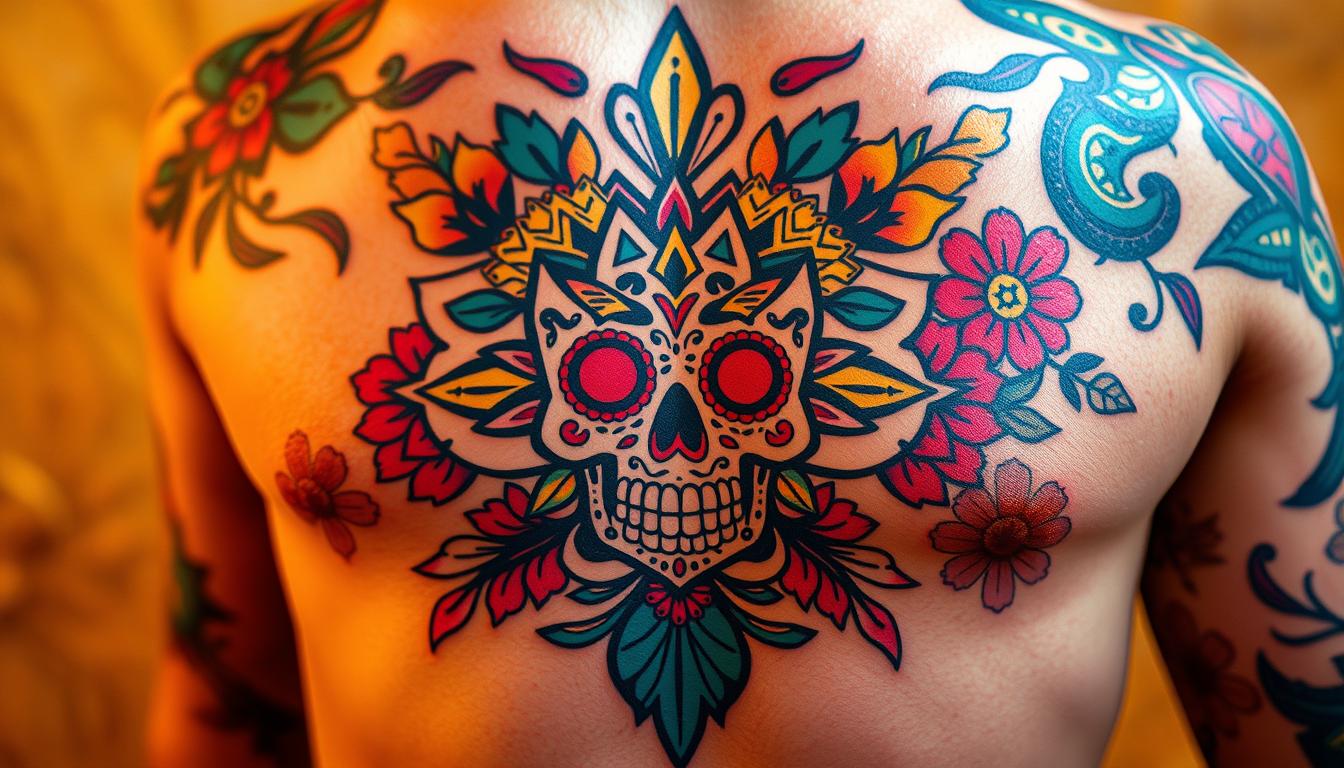
Mexican tattoos have a rich history that spans thousands of years, reflecting the country’s diverse cultural heritage. From ancient Aztec and Mayan civilizations to modern-day designs, these tattoos are not just visually striking but also carry deep symbolic meanings.
The significance of tattoo art in Mexico is evident in its blend of pre-Hispanic imagery, colonial influences, and contemporary artistic expressions. The Virgin of Guadalupe’s church, being one of the most visited Catholic sites, is a testament to Mexico’s profound cultural symbolism that inspires many tattoo designs.
Understanding the history and symbolism behind these tattoos can help appreciate their cultural importance and personal significance. Whether you’re drawn to ancient indigenous symbols, religious iconography, or revolutionary figures, Mexican tattoo art offers a diverse range of designs that connect wearers to their heritage and cultural identity.
Key Takeaways
- Mexican tattoos represent a rich cultural heritage, blending historical and modern elements.
- The history of these tattoos dates back to ancient civilizations, holding spiritual and social significance.
- Modern designs range from indigenous symbols to religious and revolutionary imagery.
- Understanding the symbolism is key to appreciating the cultural importance of these tattoos.
- Mexican tattoos serve as a connection to one’s heritage and cultural identity.
The Rich Heritage of Mexican Tattoo Art
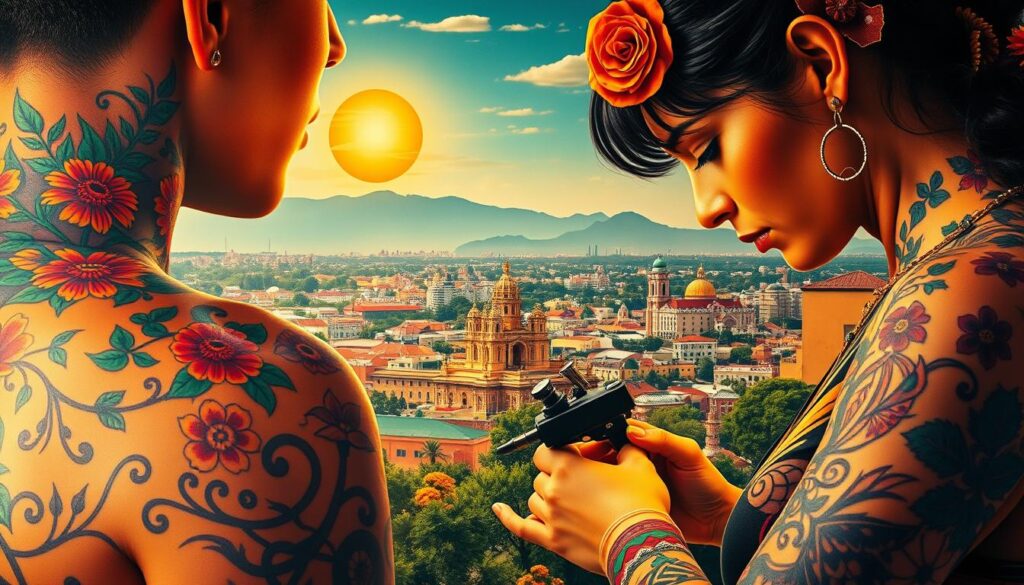
Mexican tattoo art is deeply rooted in a rich cultural heritage that spans centuries. The history of these tattoos is a complex tapestry woven from the threads of indigenous cultures, colonial influences, and modern artistic innovations.
Pre-Hispanic Origins of Mexican Tattoos
The origins of Mexican tattoos can be traced back to the ancient Aztec and Mayan civilizations. In these cultures, tattoos served as important markers of social status, religious devotion, and warrior accomplishments. The Aztecs, for instance, used tattoos to represent their status, immortalize their exploits in battle, and honor their gods, typically using black or gray ink.
- Indigenous Mexican cultures utilized natural pigments derived from plants and minerals to create permanent body markings.
- These early tattoos were often applied with bone or cactus needle tools during ceremonial rituals, highlighting their cultural significance.
Evolution Through Colonial Times
The Spanish conquest and colonial period brought significant changes to Mexican tattoo traditions. Catholic imagery began to blend with indigenous symbolism, creating unique hybrid designs that reflected Mexico’s evolving cultural identity. Throughout this time, tattoos became a form of resistance and cultural preservation for indigenous communities, allowing them to maintain connections to their heritage despite oppression.
Modern Mexican Tattoo Renaissance
The modern Mexican tattoo renaissance began in the mid-20th century with the Chicano movement, which embraced tattoos as expressions of cultural pride and identity among Mexican-Americans. Today’s Mexican tattoo artists continue this legacy by blending traditional imagery with contemporary techniques, creating works that honor historical traditions while embracing modern artistic innovations. For more information on Aztec tattoos, you can visit https://nailcutandink.com/aztec-tattoos/.
This rich heritage makes Mexican tattoo art particularly meaningful, as each design carries layers of cultural history and symbolism that connect wearers to Mexico’s complex past.
Cultural Significance of Mexican Tattoos
Mexican tattoos are more than just body art; they represent a deep connection to cultural heritage. These tattoos serve as a visual representation of Mexico’s rich history, blending ancestral traditions with modern expressions.
Tattoos as Cultural Identity
Mexican tattoos are powerful expressions of cultural identity, allowing individuals to visibly connect with their heritage. For many Mexican and Mexican-American people, tattoos function as living cultural documents that preserve and celebrate traditions.
Religious and Spiritual Connections
Religious imagery in Mexican tattoos reflects deep spiritual connections to Catholicism and indigenous belief systems. The Virgin of Guadalupe, Mexico’s patron saint, frequently appears in tattoo art as a symbol of protection and motherly love.
Celebrating Mexican Pride Through Body Art
Mexican pride tattoos celebrate national symbols, revolutionary heroes, and cultural icons, serving as permanent declarations of patriotism and cultural affirmation. These tattoos create visual bridges between personal identity and collective heritage.
In summary, Mexican tattoos are not just decorative; they carry significant cultural and spiritual meaning, representing a blend of indigenous and Catholic influences. They serve as a means of expressing identity, heritage, and pride, making them a meaningful form of body art for those connected to Mexican roots.
Aztec and Mayan Tattoo Designs
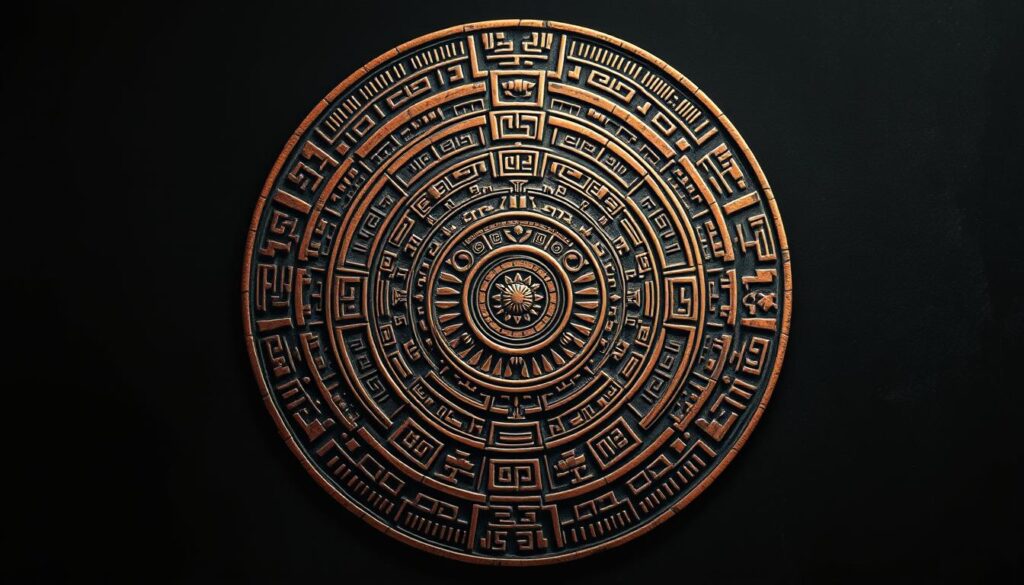
The rich cultural heritage of Mexico is reflected in its Aztec and Mayan tattoo designs, which continue to captivate tattoo enthusiasts worldwide. These ancient civilizations have left a lasting legacy in the world of tattoo art, with designs that are both visually striking and rich in symbolism.
Aztec Calendar and Cosmic Symbols
Aztec calendar tattoos are among the most intricate and symbolically rich designs in Mexican tattoo art. These designs often feature the famous Sun Stone, with its complex cosmic symbols and representations of time cycles. The circular calendar designs typically incorporate the face of Tonatiuh, the sun god, at the center, surrounded by the 20 day signs of the Aztec calendar. This makes for a visually striking and deeply meaningful tattoo that resonates with those interested in the mystique of ancient Mexico.
Mayan Hieroglyphs and Their Meanings
Mayan hieroglyphs offer a vast library of ancient symbols with specific meanings, allowing for personalized tattoo designs that can represent names, dates, concepts, or spiritual beliefs. This sophisticated writing system is not only aesthetically pleasing but also carries deep cultural significance, making it a popular choice for those seeking a meaningful tattoo.
Ancient Warrior Imagery
Ancient warrior imagery in Mexican tattoos draws from depictions of Aztec Eagle and Jaguar warriors, elite military orders whose distinctive animal-inspired regalia makes for powerful and masculine tattoo designs. These designs symbolize strength, courage, and martial prowess, appealing to those who identify with these qualities.
Jaguar Symbolism in Indigenous Tattoos
Jaguar symbolism holds particular importance in indigenous Mexican tattoo art, as this apex predator represented strength, leadership, and spiritual power in both Aztec and Mayan cultures. Jaguar tattoos are not only visually striking but also carry deep symbolic meanings, making them a popular choice among tattoo enthusiasts who appreciate the rich cultural heritage of Mexico.
In conclusion, Aztec and Mayan tattoo designs continue to inspire contemporary tattoo art with their intricate patterns, rich symbolism, and cultural significance. Whether it’s the cosmic wisdom of the Aztec calendar, the personalized meanings of Mayan hieroglyphs, the strength of ancient warrior imagery, or the spiritual power of jaguar symbolism, these designs offer a wealth of inspiration for those seeking a meaningful and visually striking tattoo.
Day of the Dead Tattoo Symbolism
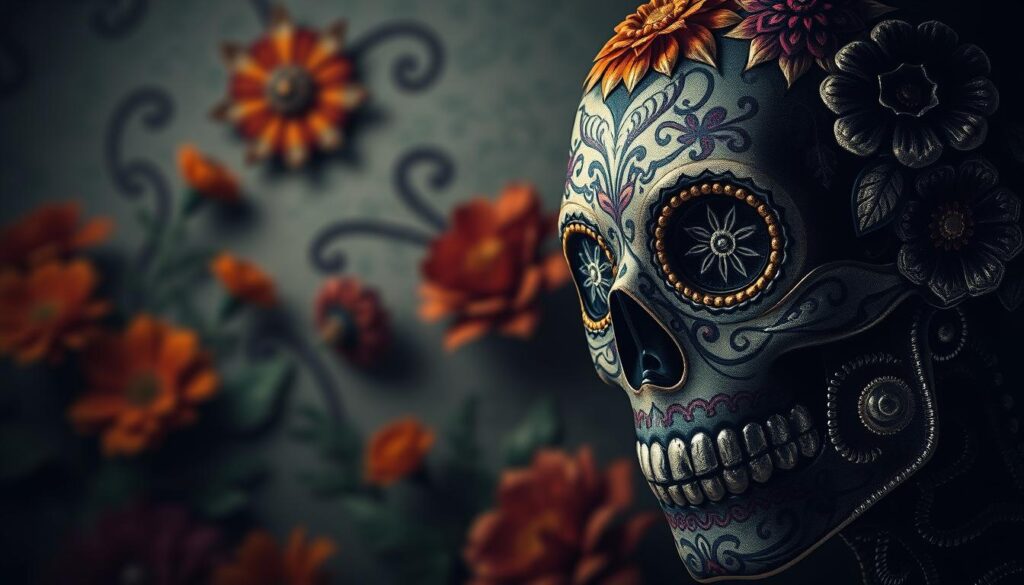
In Mexico, the celebration of life and death is vividly expressed through Day of the Dead tattoo symbolism. This cultural tradition is not just about mourning; it’s a vibrant celebration that honors the deceased with colorful skull tattoos and other symbolic imagery.
Sugar Skull (Calavera) Designs
Sugar skull designs are a hallmark of Day of the Dead tattoo art. These ornately decorated skulls are adorned with flowers, swirls, and geometric patterns, symbolizing the celebration of departed loved ones rather than mournful remembrance. The use of bright colors and decorative elements transforms these skull designs into vibrant works of art.
- The symbolism behind these tattoos reflects the Mexican cultural approach to death as a natural part of life’s journey.
- La Catrina tattoos depict the elegant female skeleton figure created by artist José Guadalupe Posada, popularized by Diego Rivera.
- Marigold flowers feature prominently in Day of the Dead tattoo art, guiding spirits back to the world of the living.
La Catrina Tattoos
La Catrina, or La Catrina Calavera, is an emblematic Mexican figure representing the equalizing nature of death. This tall, elegant skeleton woman wears a French hat adorned with flowers, embodying the beauty in embracing mortality.
Marigold Flowers in Day of the Dead Art
The marigold flower, known as the “flower of the dead” since Aztec times, plays a significant role in Day of the Dead celebrations. These vibrant orange blooms are believed to guide spirits back to the world of the living during the annual celebration, making them a popular motif in tattoo designs.
The combination of skulls, flowers, and celebratory imagery in these tattoos creates a uniquely Mexican aesthetic that balances the somber reality of death with vibrant celebration of life and remembrance.
Religious Mexican Tattoo Designs
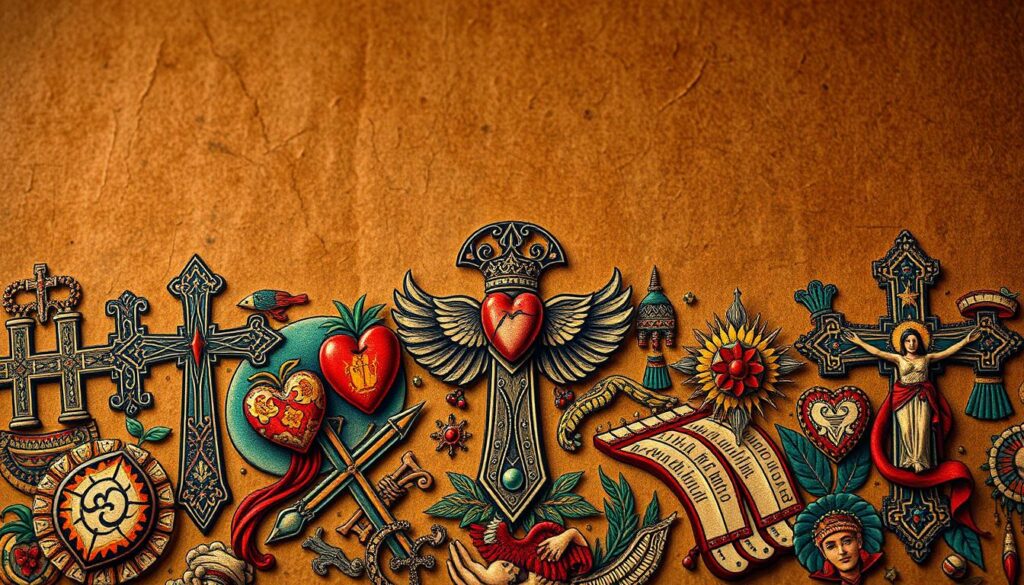
Mexico’s rich religious history is a common theme in its tattoo art. Religious Mexican tattoo designs reflect the country’s deep Catholic roots and the blending of indigenous spirituality with Catholic traditions.
Virgin of Guadalupe Imagery
The Virgin of Guadalupe is a revered figure in Mexican culture, symbolizing divine protection and Mexican identity. Tattoos of the Virgin of Guadalupe often feature her iconic mandorla, rays of light, and the angel at her feet, incorporating elements of Mexican folk art.
Sacred Heart Tattoos
Sacred Heart tattoos, depicting the flaming heart of Jesus, are another significant religious design. These tattoos symbolize divine love and sacrifice, often incorporating vibrant colors and decorative elements that reflect Mexico’s artistic traditions.
Cross and Religious Symbol Variations
The cross is a fundamental symbol in Mexican religious tattoos, ranging from ornate Catholic crucifixes to folk art interpretations that include flowers, skulls, or indigenous design elements. These designs serve as expressions of faith and cultural identity.
Religious Mexican tattoo designs not only reflect the country’s complex religious heritage but also provide a means for individuals to connect with their cultural roots. Whether through the depiction of the Virgin of Guadalupe, the Sacred Heart, or various cross designs, these tattoos embody the blend of Catholic and indigenous influences that characterize Mexican religious expression.
Mexican Wildlife and Nature Tattoos

Mexican wildlife and nature tattoos draw inspiration from the country’s unique biodiversity and the symbolic significance of its flora and fauna. These tattoos not only reflect the natural beauty of Mexico but also its rich cultural heritage.
Eagle and Serpent Symbolism
The imagery of an eagle devouring a serpent, as seen on the Mexican flag, is a powerful symbol in Mexican culture. It represents the founding myth of Tenochtitlan, where the Aztecs were instructed to build their city. This eagle and serpent symbolism is a popular tattoo design, connecting wearers to their national identity and pre-Hispanic heritage.
Hummingbird Tattoos and Their Significance
Hummingbirds are revered in Mexican culture for their beauty and symbolic significance. Associated with Huitzilopochtli, the Aztec god of war, hummingbirds are believed to carry messages between the living and the dead. Their vibrant colors and dynamic movement make them a striking tattoo design, capturing both beauty and spiritual significance.
Cactus and Desert Imagery
Cactuses, particularly the nopal cactus, are significant in Mexican culture, symbolizing resilience and adaptation. Cactus and desert imagery in tattoos celebrate Mexico’s distinctive landscapes and cultural heritage. These designs are not only visually striking but also carry deep symbolic meaning.
Xoloitzcuintli (Mexican Hairless Dog) Designs
The Xoloitzcuintli, or Mexican hairless dog, is an ancient breed considered sacred by the Aztecs. Believed to guide souls to the underworld, this breed is honored through tattoos that connect to Mexico’s indigenous spiritual traditions and its unique canine diversity.
| Symbol | Significance | Tattoo Design |
|---|---|---|
| Eagle & Serpent | Founding myth of Tenochtitlan | National identity, pre-Hispanic heritage |
| Hummingbird | Messenger between living & dead | Beauty, spiritual significance |
| Cactus | Resilience, adaptation | Cultural heritage, distinctive landscapes |
| Xoloitzcuintli | Sacred breed, guides souls | Indigenous spiritual traditions |
Popular Mexican Tattoo Styles

The evolution of Mexican tattoo art has led to the creation of distinctive styles that honor traditional symbolism while embracing modern aesthetics. Talented artists throughout Mexico combine age-old symbolism with modern techniques to create pieces that celebrate both heritage and innovation.
Chicano Style Tattoos
Chicano style tattoos emerged from Mexican-American prison and street culture in the 1960s-70s. Characterized by fine-line black and gray work, this style features distinctive imagery including religious symbols, lowriders, clowns, and stylized lettering. It developed as a form of cultural resistance and identity affirmation, with artists creating sophisticated artwork that expressed pride in Mexican-American heritage.
Neo-Traditional Mexican Designs
Neo-traditional Mexican designs blend classic tattoo techniques with vibrant colors and stylized interpretations of traditional Mexican imagery. These bold, graphic pieces feature strong outlines and saturated colors, often incorporating Day of the Dead imagery, folk art patterns, and pre-Hispanic symbols with a contemporary artistic sensibility.
Minimalist Mexican Tattoo Interpretations
Minimalist Mexican tattoo interpretations strip traditional symbols to their essential elements, using fine lines, negative space, and geometric simplification to create subtle yet meaningful designs. This approach makes Mexican cultural symbols more accessible for smaller placements or for those who prefer understated tattoo art while maintaining connections to the rich symbolic traditions of Mexican culture.
These popular Mexican tattoo styles showcase the versatility and richness of Mexican art, offering a range of choices for those looking to express their cultural connection or appreciation through body art.
Mexican Folk Art Inspired Tattoos
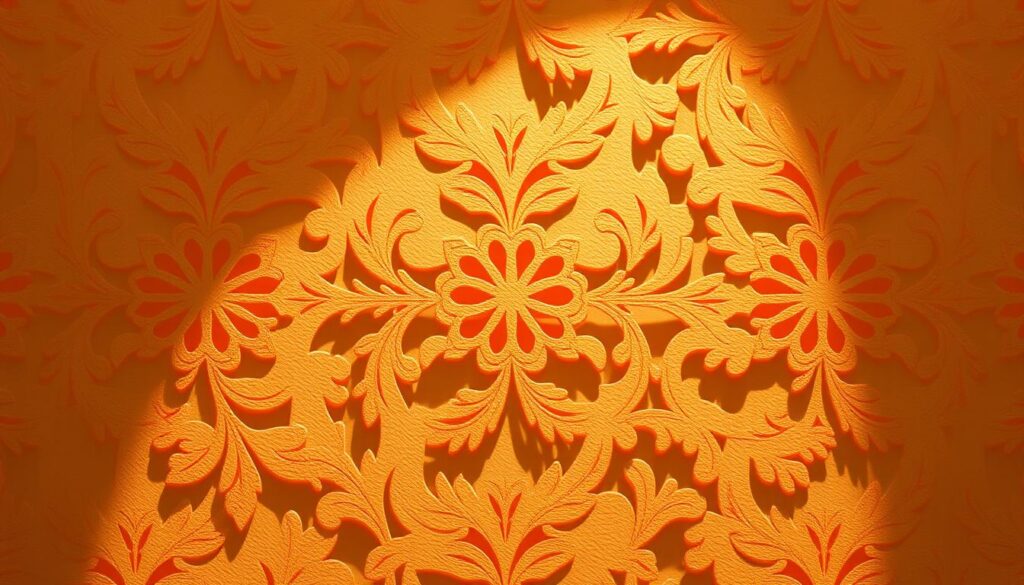
Mexican folk art, with its intricate patterns and symbolic imagery, has been adapted into stunning tattoo designs. This unique style of body art celebrates Mexico’s rich cultural heritage by translating traditional handcrafts and decorative arts into wearable expressions of art.
Papel Picado Designs
Papel picado, or paper cutting, is a traditional Mexican craft that has been transformed into tattoo art. These designs feature delicate patterns, symbols, and scenes that evoke the festive spirit of Mexican celebrations. Common elements include birds, flowers, skeletons, and geometric patterns arranged in banner-like compositions.
Mexican Embroidery Tattoos
Mexican embroidery tattoos draw inspiration from the vibrant needlework traditions of regions like Oaxaca and Chiapas. These tattoos recreate the distinctive floral patterns, animal motifs, and geometric designs of traditional embroidery, rendered to look like thread on skin. Specialized techniques create the illusion of stitching, giving the designs a textured, three-dimensional quality.
La Lotería Card Imagery
La Lotería card imagery is another rich source of inspiration for mexican tattoo designs. Each of the game’s 54 cards offers distinctive, culturally significant images that make for bold, recognizable tattoos. Popular choices include El Corazón (the heart), La Sirena (the mermaid), El Sol (the sun), and La Calavera (the skull), each carrying its own symbolic associations.
| Design Element | Cultural Significance | Tattoo Style |
|---|---|---|
| Papel Picado | Festive celebrations, traditional craft | Delicate, banner-like compositions |
| Mexican Embroidery | Vibrant needlework traditions | Floral, animal motifs, geometric designs |
| La Lotería Cards | Culturally significant imagery | Bold, recognizable designs |
In conclusion, tattoos inspired by Mexican folk art offer a unique way to celebrate cultural heritage through body art. By incorporating traditional designs and imagery, individuals can wear their cultural pride on their skin.
Revolutionary and Patriotic Mexican Tattoos
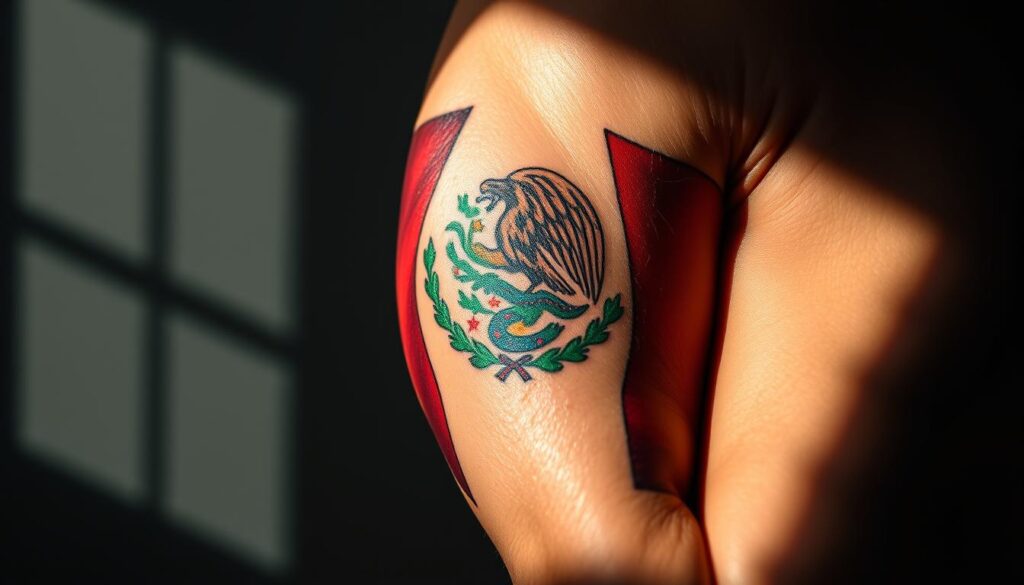
Patriotic and revolutionary themes are prevalent in Mexican tattoos, celebrating the country’s history and the heroes who shaped it. These tattoos often feature symbols and imagery that reflect Mexico’s struggle for independence and its rich cultural heritage.
The Mexican Flag in Tattoo Designs
The Mexican flag is a powerful symbol of national pride, and its incorporation into tattoo designs is a testament to the country’s strong sense of identity. The flag’s three colors – green, white, and red – hold significant meaning, representing independence, purity, and the blood of national heroes, respectively. Mexican flag tattoo designs often include the distinctive eagle and serpent emblem, symbolizing the country’s rich history and cultural identity.
Revolutionary Heroes and Figures
Revolutionary heroes such as Emiliano Zapata, Pancho Villa, and Miguel Hidalgo are frequently featured in Mexican tattoos. These figures are revered for their roles in the country’s struggle for independence and social justice. Their images are often portrayed in heroic, idealized forms, emphasizing their revolutionary spirit and contribution to Mexican national identity.
| Hero | Significance |
|---|---|
| Emiliano Zapata | Leading figure in the Mexican Revolution, advocating for land reform. |
| Pancho Villa | Key leader in the Mexican Revolution, known for his military prowess. |
| Miguel Hidalgo | Initiated the Mexican War of Independence with the Grito de Dolores. |
Cultural Icons like Frida Kahlo
Cultural icons like Frida Kahlo have become increasingly popular subjects for Mexican-inspired tattoos. Kahlo’s distinctive self-portraits and unique personal style make for instantly recognizable and visually striking designs. Her imagery often incorporates elements from her artwork and personal symbolism, celebrating not only her artistic contributions but also her embodiment of Mexican cultural identity.
Frida Kahlo tattoos often symbolize resilience, creativity, and the celebration of Mexican culture. They serve as a tribute to her pioneering role as a female artist who challenged conventions and left a lasting legacy in the art world.
Choosing Your Perfect Mexican Tattoo Design
To find your perfect Mexican tattoo, you need to explore the cultural elements that speak to you on a personal level. A meaningful tattoo design is one that balances personal significance with artistic expression.
Personal Connection Considerations
Choosing your perfect Mexican tattoo design begins with understanding your personal connection to Mexican culture. This could be through heritage, spiritual affinity, aesthetic appreciation, or meaningful life experiences. Consider what aspects of Mexican culture resonate most deeply with you—whether it’s religious symbolism, pre-Hispanic imagery, folk art traditions, or revolutionary figures.
Placement and Size Options
The size and placement of your Mexican tattoo substantially affect its appearance. Different sizes suit different body parts. For instance:
| Size | Body Part | Design Suitability |
|---|---|---|
| Small (2-3 inches) | Wrist, ankle, or lower arm | Minimalist designs |
| Medium (3-5 inches) | Forearm, collarbone, or upper arm | Detailed symbols |
| Large (6+ inches) | Back, chest, or thigh | Elaborate cultural scenes |
Finding the Right Tattoo Artist
Finding the right tattoo artist is crucial for Mexican designs, as they require specific knowledge of cultural symbolism and often specialized techniques. Look for artists who specialize in Mexican or Chicano style tattoos and review their portfolios for similar work.
By considering your personal connection, the appropriate size and placement, and finding the right artist, you can ensure your Mexican tattoo is both authentic and meaningful.
Conclusion: The Enduring Appeal of Mexican Tattoos
The allure of Mexican tattoos lies in their unique blend of historical depth and contemporary artistic expression. Mexican tattoo art creates a powerful connection between ancient traditions and modern expression, allowing these tattoos to tell stories across generations.
Mexican tattoos serve as living connections to Mexico’s complex cultural heritage, from pre-Hispanic civilizations through colonial influences to modern artistic innovations. This rich cultural background makes them particularly meaningful in our increasingly globalized world. For people of Mexican heritage, these tattoos provide a permanent way to honor their roots and maintain cultural connections.
The versatility of Mexican tattoo imagery allows for highly personalized expressions, whether through religious devotion, cultural celebration, artistic appreciation, or personal storytelling. As tattoo art continues to gain mainstream acceptance worldwide, Mexican designs stand out for their distinctive aesthetic qualities and rich symbolism.
The global popularity of Mexican tattoo styles speaks to their universal appeal and the way they address fundamental human themes—life, death, spirituality, family, and cultural identity—through a uniquely Mexican visual language. Whether chosen for deep personal significance or pure aesthetic appreciation, Mexican tattoos continue to evolve while maintaining their connection to the rich cultural traditions that have made them one of the world’s most distinctive and beloved tattoo styles.
In conclusion, the enduring appeal of Mexican tattoos lies in their ability to balance tradition with contemporary artistic expression, making them a significant part of cultural identity and personal expression worldwide.
